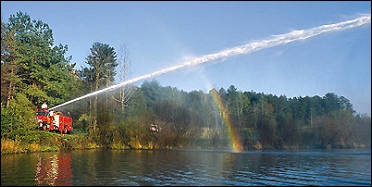Super Soaker
A dry hydrant on your pond not only protects your home but also can save a bundle on your homeowner's insurance.
David James climbs atop his fire truck, points the water cannon over a scenic state park lake and releases a long, arching jet of water. Soon his long black hair is soaked with mist carried by gentle winds in the clear late-afternoon skies. The display is impressive, demonstrating the fire protection anyone in a remote area can have if they have a pond nearby-and if they have a dry hydrant installed.

PHOTO: John Leidner
"You can get 1,100 gallons of water per minute from a dry hydrant if the lift is no more than 10 feet," says Holcombe, a captain with the Pumpkintown Volunteer Fire Department in Pickens County, S.C.
James is well acquainted with dry hydrants. The Pumpkintown fire department covers 98 square miles and relies heavily on the 26 dry hydrants in the community.
It takes close to 5,000 gallons to extinguish a typical rural fire. And dry hydrants can give firefighters all the water they need to quench such a blaze.
Dry hydrants are simple devices. They're called dry because they are not pressurized like fire hydrants in towns and cities. Most dry hydrants are made of simple PVC pipe. They are installed in ponds, lakes or streams, and they allow pumper trucks to draft water and tanker trucks to shuttle the water to the fire scene.
Partly due to the presence of the dry hydrants, 1,100 homeowners in the Pumpkintown community have saved money on premiums they pay for fire insurance. "Mine were cut in half," says Fire Chief Roy Holcombe.
Dry hydrants alone won't automatically lower insurance premiums-it also depends on the equipment and training of local fire departments. But they certainly help.
The Insurance Services Office, which provides fire-insurance ratings, gives areas without fire departments a rating of 10. As fire protection increases, the ISO rating number decreases, and premiums follow suit. When dry hydrants were installed in the Pumpkintown community, its rating dropped from 9 to 7.
Stan Merrett has been involved with dry hydrants since the late 1980s and owns a number of patents on dry-hydrant components. A firefighter himself, Merrett heads Emergency Technology & Tactics, a firm based in Dadeville, Alabama, that designs and sells dry hydrants.
Merrett says homeowners should see a reduction in fire-insurance premiums if they live within 5 miles of a fire department, if they have a dry hydrant within 1,000 feet of their residence and if the lift on the dry hydrant is no more than 15 feet. Dry hydrants are catching on. As part of a master fire plan for Arkansas, Merrett conducted a county-by-county survey and found that most departments with access to dry hydrants had used them at least once during the past two to three years.
Installations of dry hydrants in many states had been funded by Natural Resources Conservation Service-sponsored Resource Conservation and Development councils. In recent years, these groups have shifted priorities to other projects and are now largely out of the business of promoting dry hydrants. But Merrett is encouraged by new laws in states such as Maryland and New Jersey that require fire protection for new housing. He says new rural subdivisions in these states are protected by buried fiber-glass tanks equipped with dry hydrants.
For homeowners who wish to invest in a dry hydrant on their own property, Merrett advises working closely with local fire departments. This is the best way to ensure that hydrant components fit the department's equipment and that the dry hydrant will be accessible to fire trucks.
Merrett says, "I'd encourage fire departments and landowners to look on dry hydrants as something that could be of mutual benefit."
Hydrant Hints
Water. Obvious places for a dry hydrant are next to ponds, lakes, rivers and streams. But they also can be put to use with swimming pools, irrigation wells and buried underground tanks. In parts of Texas where there are few ponds, Merrett has seen dry hydrants added to large cattle-watering tanks. "These tanks are typically 5 to 6 feet tall and are connected to windmills," says Merrett. "I've put in several of those type of tanks, using an up-and-over design for the dry hydrants."
Site selection. Ideally you want a permanent supply of at least 30,000 gallons of water, even during a drought. Fire trucks need quick access, which requires an all-weather road and adequate space for turning around and parking. For fire protection for the entire community, there should be at least one dry hydrant every 3 square miles. The water source should be deep enough to maintain 18 inches of water over the intake strainer and 12 inches underneath it. Also, it usually is easier and cheaper to install dry hydrants while a pond is being built rather than later on.
Cost. Total costs could exceed
$1,000 if professionals are hired for site investigation, engineering
design, installation and road construction. However, costs should
be much less if the NRCS, local fire departments and road crews
from local governments are willing to pitch in and help. Many
USDA-NRCS offices will provide dry-hydrant designs at no cost
to landowners. Stan Merrett's firm sells intake strainers for
$65 each and dry-hydrant heads for $135 each. The pipe is made
of 6-inch, schedule-40 PVC pipe. It can be purchased for about
$4.25 per foot. About 80 feet of PVC pipe is required
for a typical installation.
Want more information? If you have questions about dry hydrants, contact your local NRCS office or fire department.
